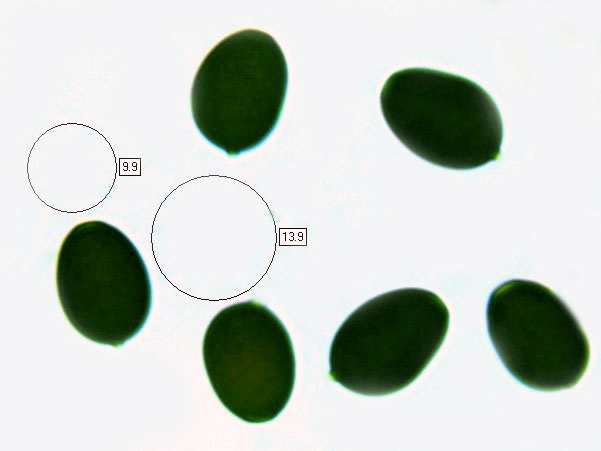Coprinopsis picacea (Bull.) Redhead, Vilgalys & Moncalvo - Magpie Inkcap
Phylum: Basidiomycota - Class: Agaricomycetes - Order: Agaricales - Family: Psathyrellaceae
Distribution - Taxonomic History - Etymology - Identification - Toxicity - Reference Sources
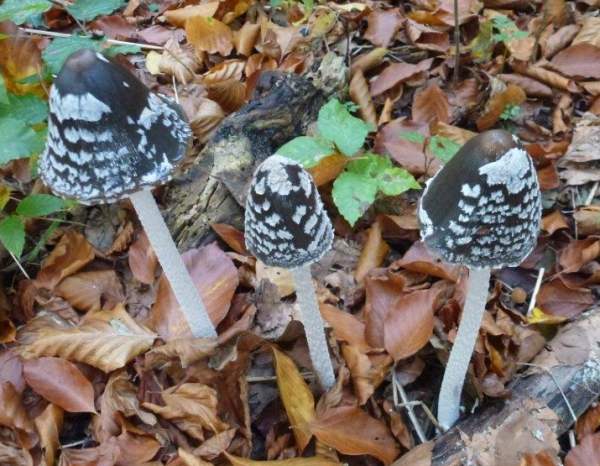
It is always a delight to come across a Magpie Inkcap. So often are they solitary or so spaced that those of us who like to photograph our finds have little prospect of capturing a photogenic group (a ‘parliament’ of magpies) that we can crow about to others! Just occasionally Magpie Inkcaps occur in small groups, as was the case with the lovely trio in the picture above taken in Herford, Germany, in October 2013.
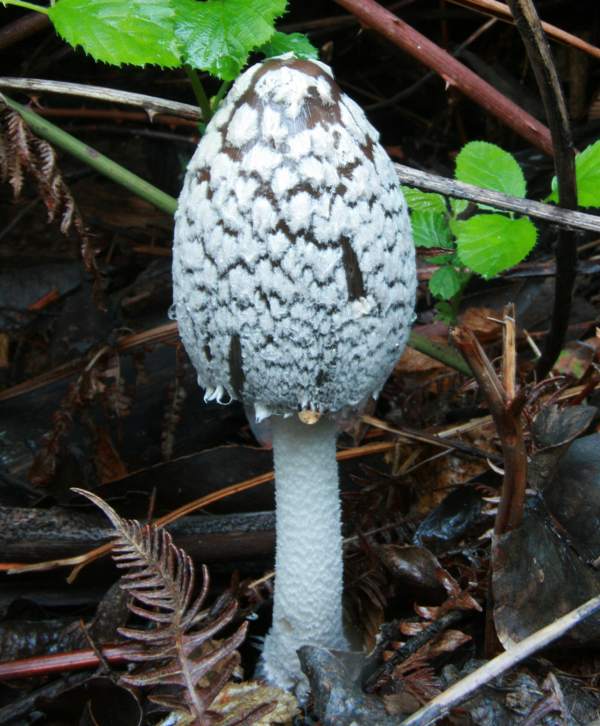
The wonderful patterning of white or silvery grey on a shiny dark-brown background makes this one of the most beautiful mushrooms to photograph for reproduction as a monochrome print.
Like all inkcaps the fruitbodies are short lived, and so a patient observer could have an educational day watching a cap expand from an elongated egg to conical and then bell-like as the cottony universal veil remnant breaks into separate patches to reveal the glossy dark background.
As with other large inkcaps, the gills of the Magpie Inkcap deliquesce, a process which aids spore dispersal particularly in wet weather.
Distribution
Infrequent in Britain and Ireland, the Magpie Inkcap is found throughout Europe but most commonly in areas with alkaline soil. Unusually, the lovely pair of Magpie Inkcaps shown below were seen in Sherwood Forest (Nottinghamshire, England) , an acid-soil area.
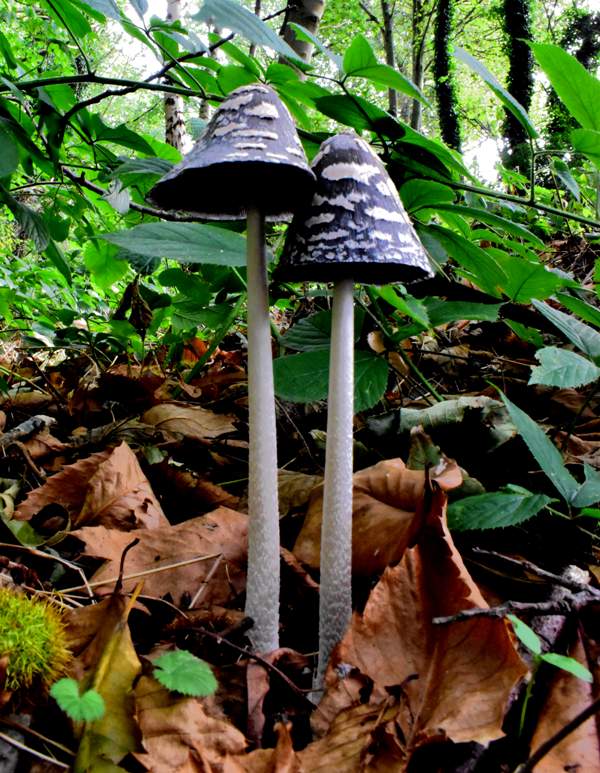
This attractive species occurs also in parts of North America. Usually solitary, occasionally Magpie Inkcaps occur in small group, as in the picture on the left, taken by Ian Smith in Herford, Germany, in October 2013.
Taxonomic history
The Magpie Inkcap was first described scientifically in 1785 by Jean Baptiste Francois Pierre Bulliard, who gave it the scientific name Agaricus picaceus.
(Vast numbers of gilled fungi were dumped into the Agaricus genus in the early days of fungal taxonomy; most have since been moved to other genera leaving in the present-day Agaricus genus a much smaller number of gilled mushrooms that are sometimes referred to as the 'true mushrooms'.)
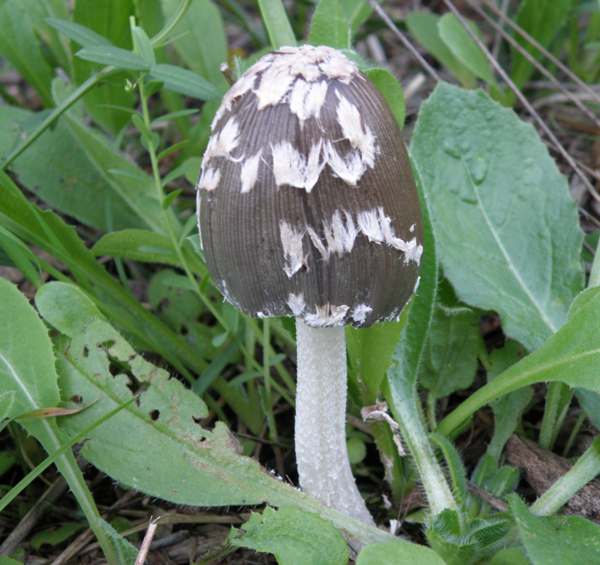
The Magpie Inkcap was known by the name that Bulliard gave it until 2001 when, as a result of molecular (DNA) analysis by Redhead, Vilgalys & Moncalvo, the large Coprinus genus was shown to contain groups of fungi with only distant relationships to one another, and the earlier Coprinus group was dismantled with the Magpie Inkcap being moved into the genus Coprinopsis within the family Psathyrellaceae. Coprinus comatus, the Shaggy Inkcap (with which the Magpie Inkcap is sometimes confused) plus three other rare fungi are all that now remains of the formerly large Coprinus genus; however, many field guides and websites are yet to be updated in this respect.
Etymology
The generic name Coprinopsis indicates that mushrooms in this genus are similar in appearance to those in the genus Coprinus, which literally means 'living on dung' - that's true of quite a few of the inkcaps but not particularly apt for this and several other species.
The specific epithet picacea comes from the Latin scientific name for the Eurasian Magpie, Pica pica.
Common names change with time and location. In America the terms Inky Cap or Inky-cap are most commonly used, while in many older field guides published in Britain you are likely to see Ink Cap or Ink-cap rather than Inkcap.
The specimen shown immediately above was photographed in the Algarve region of southern Portugal; its cap background is very dark brown (almost black) and fully justifies the common name reference to a magpie, which in Britain and Ireland at least is a black-and white bird. Enigmatically, magpies with blue backs - Azure-backed Magpies - are far more common in southern Portugal, and unlike Magpie Inkcaps which are always quire rare and therefore special finds, they appear to be on the increase.
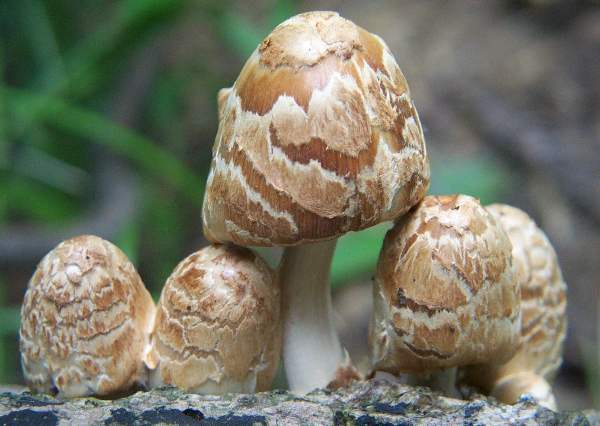
In some parts of the world, rather than having white scales upon a dark brown cap background there are magpie-like inkcaps with buff scale patches a mid-brown or tan background, as in the examples on the left. This impressive group of Coprinopsis variegata inkcaps was found and photographed in the USA.
Magpies - the birds, that is - are considered by some people to be bad omens; certainly their habit of stealing birds eggs and young birds from the nest does little to endear them to lovers of songbirds. An old nursery rhyme about magpies goes: One for sorrow; Two for joy; Three for a girl; Four for a boy, etc. There are several other versions, with variations on lines three onwards, but they all retain the One for sorrow; Two for joy opening lines. Magpies pair for life, and so seeing just one of these birds could mean that its mate has died - one for sorrow! Seeing two (or more) Magpie Inkcaps on a fungus foray is a real joy but, in most parts of Britain and Ireland at least, all to uncommon.
Toxicity
Unlike the Shaggy Inkcap, the Magpie Inkcap is reported to be poisonous - perhaps further evidence of the genetic distance between them. In any case these are quite rare finds in most areas and best left for others to see and enjoy.
Identification guide
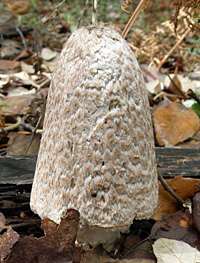 |
CapAt maturity the caps of Coprinopsis picacea are 3 to 7cm across and 7 to 12cm tall; initially egg-shaped, becoming bell shaped, the margins turning outwards before blackening and deliquescing from the rim; very dark grey-brown glossy background covered with silvery-white fibrils that separate into patches as the cap expands. The young cap shown here has not yet expanded fully, and at this stage it could be mistaken for a Shaggy Inkcap, Coprinus comatus. GillsAdnate or free, the gills of the Magpie Inkcap are crowded, white, turning reddish and then black before deliquescing. |
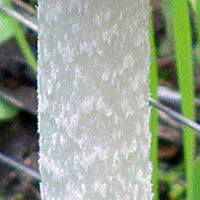 |
Stem10 to 20cm long and 0.7 to 1.5cm diameter, the surface of the stem of the Magpie Inkcap, Coprinopsis picacea, is white and floccose; its stem base is often slightly bulbous. |
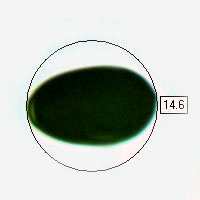 |
SporesEllipsoidal, smooth, 13-19 x 9-12µm; with a central germ pore. Spore printBlack. |
Odour/taste |
Not distinctive. |
Habitat & Ecological role |
Generally as solitary specimens or well spaced in small groups, Magpie Inkcaps occur most often in deciduous woodland, particularly under Beech trees and less frequently under oaks. They are rare finds in Britain and Ireland, where they are mainly restricted to alkaline areas. Occasionally I find them also in damp, well-shaded grassland where deciduous hardwood debris has collected at the edge of a floodplain. |
Season |
May to November in Britain and Ireland; later in southern Europe. |
Similar species |
It would be difficult to mistake this lovely inkcap for any other species once its cap has begun expanding to reveal the glossy dark-brown background underlying the white patches. |
Reference Sources
Fascinated by Fungi, 2nd Edition, Pat O'Reilly 2016, reprinted by Coch-y-bonddu Books in 2022.
Orton, P.D. & Watling, R. (1979). British Fungus Flora: Agarics and Boleti. Vol 2. Coprinaceae: Coprinus. Royal Botanic Garden: Edinburgh.
Redhead SA, Vilgalys R, Moncalvo J-M, Johnson J, Hopple JS Jr.; Vilgalys, Rytas; Moncalvo, Jean-Marc; Johnson, Jacqui; Hopple, Jr. John S (2001). 'Coprinus Pers. and the disposition of Coprinus species sensu lato.'. Taxon (International Association for Plant Taxonomy (IAPT)) 50 (1): 203–41.
English Names for fungi; British Mycological Society, 2013.
Dictionary of the Fungi; Paul M. Kirk, Paul F. Cannon, David W. Minter and J. A. Stalpers; CABI, 2008
Taxonomic history and synonym information on these pages is drawn from many sources but in particular from the British Mycological Society's GB Checklist of Fungi.
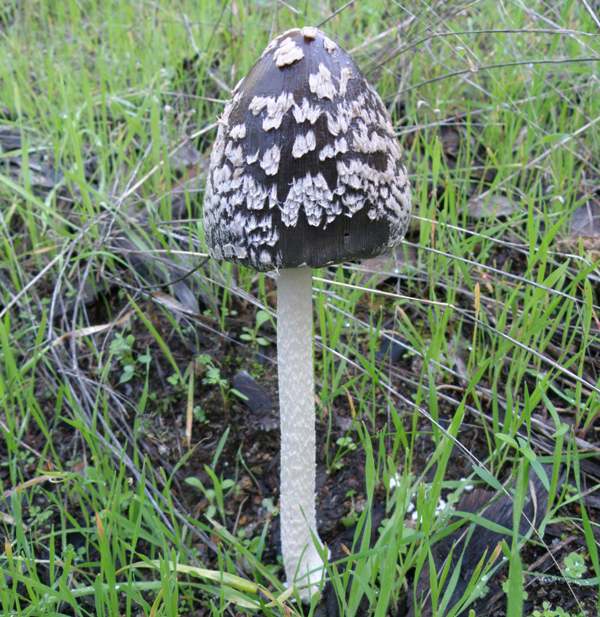
Acknowledgements
This page includes pictures kindly contributed by Doug Holland, Ross Holland, and Ian Smith.
Fascinated by Fungi. Back by popular demand, Pat O'Reilly's best-selling 450-page hardback book is available now. The latest second edition was republished with a sparkling new cover design in September 2022 by Coch-y-Bonddu Books. Full details and copies are available from the publisher's online bookshop...
